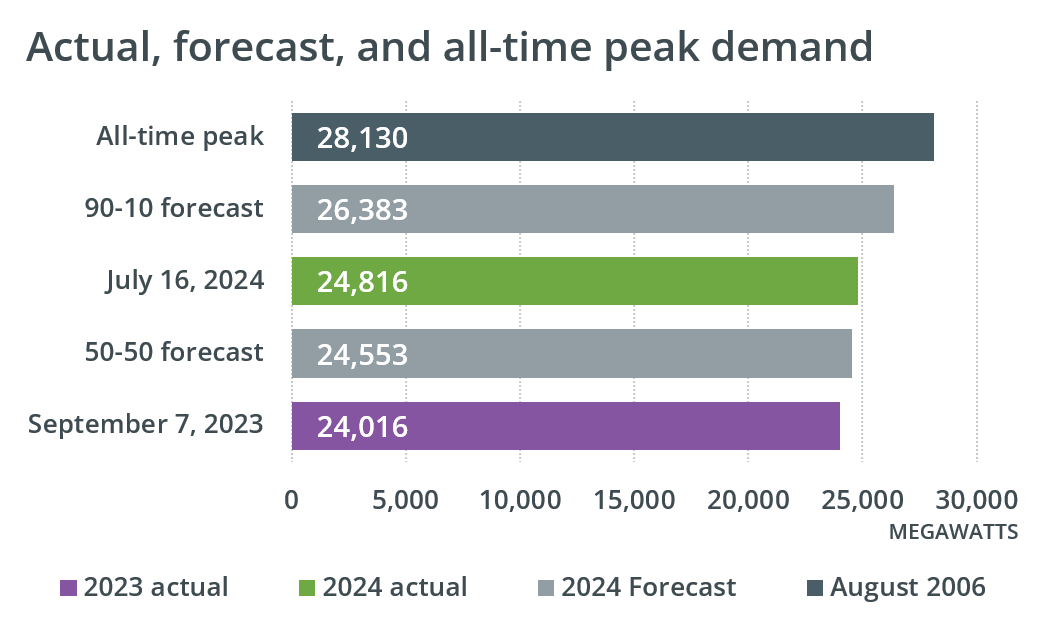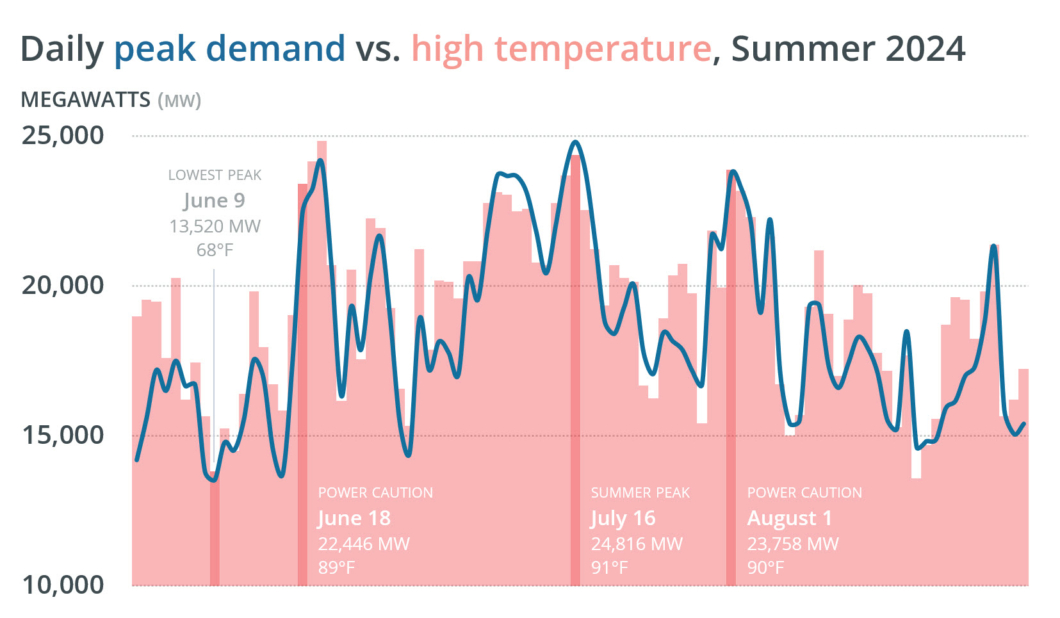Summer 2024 recap: Grid reliability maintained through heat waves

New England’s power grid operated reliably in June, July, and August, including two hot periods that contributed to tight system conditions.
Consumer demand for electricity peaked at 24,816 megawatts (MW) on July 16 between 5 and 6 p.m., when the regional average temperature was 91° Fahrenheit (F). That was roughly in line with ISO New England’s forecast summer peak of 24,553 MW under typical weather conditions. The actual peak was higher than last year’s annual peak of 24,016 MW on September 7, 2023.

This summer as a whole was relatively mild, with an average regional temperature 1.5°F above normal. New Englanders consumed about 5% more electricity this summer than last summer—33,279 gigawatt-hours (GWh) in June, July, and August of 2024 versus 31,787 GWh during the same period in 2023.
Higher peaks and greater overall energy use this summer contributed to higher wholesale electricity prices than last summer.
Reserve shortages prompt penalties
Higher-than-forecast temperatures and unexpected resource outages and reductions led to capacity scarcity conditions on June 18 and August 1. Both incidents temporarily left the region short of required operating reserves but did not result in power outages.
On both days, ISO New England system operators implemented a Power Caution and followed well-established procedures that include activating a portion of the region’s operating reserves and declaring and Emergency Energy Alert (EEA) Level 1, the lowest of three alert levels.
The August 1 capacity deficiency resulted from about 1,150 MW of unplanned resource outages and reductions throughout the day. The Power Caution remained in effect for five hours around the evening peak. The event resulted in approximately $49.9 million in penalties for underperforming resources—the greatest amount to date under the region’s Pay-for-Performance rules. The specific resources are not identified, per the ISO’s Information Policy.
The June 18 capacity deficiency occurred during a five-day heat wave, and came during a day when the region experienced about 1,600 MW of unplanned resource outages. The deficiency was mitigated within 30 minutes, and the region remained in a Power Caution for four hours as demand receded and the power system returned to normal operations. The event resulted in approximately $14.8 million in Pay-for-Performance penalties.

Wholesale prices up compared to 2023
Real-time wholesale electricity prices averaged $37.45 per megawatt-hour (MWh) this summer, up 9% from the summer 2023 average of $34.33/MWh. The increase is attributable to higher peak loads and overall demand this summer compared to last summer, as well as the price impacts of this season’s two scarcity events.
The increase in wholesale electricity prices came despite falling natural gas prices. Average natural gas prices for summer 2024 were $1.79 per million British thermal units (MMBtu), a decrease of 20% from summer 2023, when the average price was $2.24.
Resource mix and emissions
During the summer months, natural gas continued to be the primary fuel source for electricity generation in New England, accounting for 49% of energy consumed in the region. Nuclear power contributed 26%, followed by imports at 9% and hydroelectric power at 8%. Wind and grid-connected solar accounted for about 7% of energy consumed this summer. Oil and coal combined produced about 0.3%.
ISO New England estimates carbon dioxide (CO2) emissions associated with the region’s electricity use through an analysis that combines data on electricity generation by fuel type with emissions factors based on Environmental Protection Agency data and generator data reported directly to the ISO. CO2 emissions for the summer months increased by about 526,000 metric tons from the previous year, representing an increase of 6%. While emissions for June were roughly the same as the previous year, July and August saw increases of 3% and 15%, respectively, compared to the previous year. The increased emissions were also related to this season’s higher peaks and energy use.
- Categories
- Inside ISO New England
- Tags
- summer, system operations, wholesale prices
